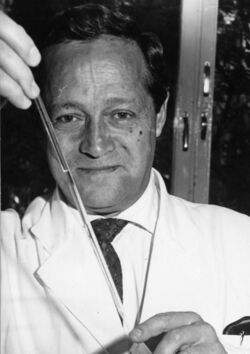Biography:Feodor Lynen
Feodor Felix Konrad Lynen | |
|---|---|
 | |
| Born | 6 April 1911 |
| Died | 6 August 1979 (aged 68) Munich, West Germany |
| Education | University of Munich |
| Scientific career | |
| Institutions | University of Munich Max Planck Society |
| Doctoral advisor | Heinrich Otto Wieland |
| Doctoral students | Dieter Oesterhelt |
Feodor Felix Konrad Lynen ForMemRS[1] (German pronunciation: [ˈfeːodoːɐ̯ ˈlyːnən] (![]() listen); 6 April 1911 – 6 August 1979) was a German biochemist. In 1964 he won the Nobel Prize in Physiology or Medicine together with Konrad Bloch for their discoveries concerning the mechanism and regulation of cholesterol and fatty acid metabolism while he was director of the Max-Planck Institute for Cellular Chemistry in Munich.
listen); 6 April 1911 – 6 August 1979) was a German biochemist. In 1964 he won the Nobel Prize in Physiology or Medicine together with Konrad Bloch for their discoveries concerning the mechanism and regulation of cholesterol and fatty acid metabolism while he was director of the Max-Planck Institute for Cellular Chemistry in Munich.
Biography
Feodor Lynen was born in Munich on 6 April 1911. His parents were Wilhelm Lynen, who taught mechanical engineering, and Frieda née Prym, whose father was an industrialist.[2] He started his studies at the chemistry department of Munich University in 1930 and graduated in March 1937 under Heinrich Wieland with the work: "On the Toxic Substances in Amanita". Lynen remained in Germany throughout World War II. In 1942 he became a chemistry lecturer at the Munich University. In 1947 he became an assistant professor and in 1953 a professor of biochemistry. From 1954 onwards he was director of the Max-Planck Institute for Cellular Chemistry in Munich, a position which was created for him at the instigation of two senior scientists, Otto Warburg and Otto Hahn. In 1972, that institute was merged into the newly founded Max-Planck Institute of Biochemistry in 1972. Also in 1972, Lynen was named President of the Gesellschaft Deutscher Chemiker (GDCh).[3]
In 1964, he won the Nobel Prize in Physiology or Medicine together with Konrad Bloch for their discoveries concerning the mechanism and regulation of cholesterol and fatty acid metabolism. These discoveries took many years to work out.[4][5][6][7] The Nobel Committee felt that this was important because understanding the metabolism of sterols and fatty acids could reveal how cholesterol affects heart disease and stroke.[8] His Nobel Lecture on 11 December 1964 was 'The pathway from "activated acetic acid" to the terpenes and fatty acids'.[9]
Working mostly separately, Lynen and Bloch both discovered the steps that created squalene and turned the squalene into cholesterol. Initially, Lynen found that acetate activated by coenzyme A was needed to start the process. He discovered the chemical structure of acetyl-coenzyme A, which was needed for a detailed understanding of the biochemical pathways.[8] He also learned that biotin, or Vitamin B7, was needed for in the process.[9]
On 14 May 1937, Lynen married Eva Wieland (1915–2002), daughter of his academic teacher. They had five children between 1938 and 1946.[3] Feodor Lynen died in Munich, Germany, on 6 August 1979, six weeks after an operation for aneurism.[8]
Fellowship
The Alexander von Humboldt Foundation has a fellowship named in his honor.
Honours and awards
- 1962: elected to the American Academy of Arts and Sciences[10]
- 1962: elected to the United States National Academy of Sciences[11]
- 1963: Otto Warburg Medal from the German Society for Biochemistry and Molecular Biology [12]
- 1964: Nobel Prize in Physiology or Medicine (with Konrad Bloch) "for their discoveries concerning the mechanism and regulation of the metabolism of cholesterol and fatty acids"
- 1965: Grand Cross of Merit with Star and Sash of the Federal Republic of Germany
- 1966: elected to the American Philosophical Society[13]
- 1967: Norman Medal of the German Society for Fat Research
- 1971: Pour le Mérite for Science and Art
- 1972: Austrian Decoration for Science and Art
References
- ↑ Cite error: Invalid
<ref>tag; no text was provided for refs namedfrs - ↑ Lindsten, Jan (1999). Physiology or Medicine, 1963-1970. World Scientific. ISBN 9789810234126. https://books.google.com/books?id=O5jQ-GRTvPUC&dq=Gustav+Prym&pg=PA139.
- ↑ 3.0 3.1 "Feodor Lynen — Biographical". Nobel Media AB. https://www.nobelprize.org/nobel_prizes/medicine/laureates/1964/lynen-bio.html.
- ↑ "β-Hydroxy-β-methyl-glutaryl coenzyme A reductase, cleavage and condensing enzymes in relation to cholesterol formation in rat liver". Biochimica et Biophysica Acta 40: 491–501. June 1960. doi:10.1016/0006-3002(60)91390-1. PMID 13805544.
- ↑ Lynen F (July 1966). "The biochemical basis of the biosynthesis of cholesterol and fatty acids" (in de). Wiener Klinische Wochenschrift 78 (27): 489–97. PMID 4296920.
- ↑ "Regulation of cholesterol biosynthesis in rat liver: diurnal changes of activity and influence of bile acids". Archives of Biochemistry and Biophysics 133 (1): 11–21. August 1969. doi:10.1016/0003-9861(69)90482-2. PMID 5810824.
- ↑ "Influence of bile acids on the activity of rat liver 3-hydroxy-3-methylglutaryl coenzyme A reductase. 1. Effect of bile acids in vitro and in vivo". European Journal of Biochemistry 18 (1): 10–4. January 1971. doi:10.1111/j.1432-1033.1971.tb01207.x. PMID 5547468.
- ↑ 8.0 8.1 8.2 "Feodor Lynen Biography (1911–1979)". Internet FAQ Archives. http://www.faqs.org/health/bios/44/Feodor-Lynen.html.
- ↑ 9.0 9.1 Lynen, Fyodor (11 December 1964). "The pathway from 'activated acetic acid' to the terpenes and fatty acids". Nobel Media AB. https://www.nobelprize.org/prizes/medicine/1964/lynen/lecture/.
- ↑ "Feodor Felix Konrad Lynen" (in en). https://www.amacad.org/person/feodor-felix-konrad-lynen.
- ↑ "Feodor Lynen". http://www.nasonline.org/member-directory/deceased-members/64609.html.
- ↑ "Otto-Warburg-Medal". GBM. http://www.otto-warburg-medaille.org/index.php/previous-award-winners.html.
- ↑ "APS Member History". https://search.amphilsoc.org/memhist/search?creator=Feodor+Lynen&title=&subject=&subdiv=&mem=&year=&year-max=&dead=&keyword=&smode=advanced.
External links
- Miss nobel-id as parameter
- Feodor Lynen's Nobel lecture, "The pathway from 'activated acetic acid' to the terpenes and fatty acids"
- Alexander von Humboldt Foundation, Feodor Lynen Research Fellowships
 |



